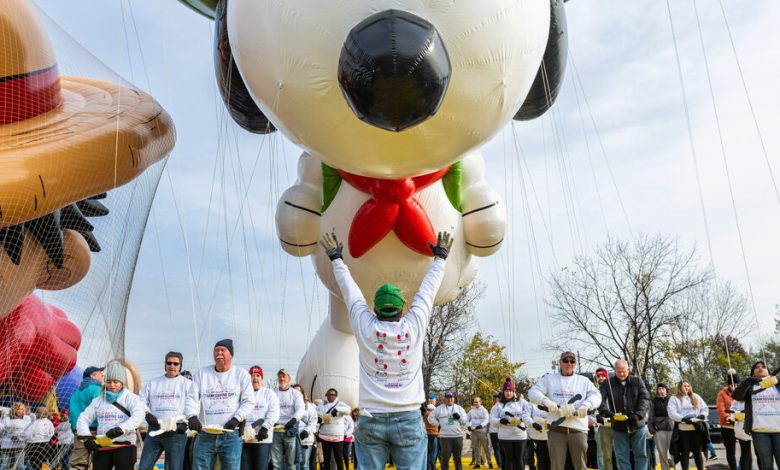What It Takes for Snoopy and Friends to Soar in the Macy’s Parade

It has become Paul Schwartz’s job to help ensure the safety of millions of Thanksgiving parade watchers — as New York City’s “chief balloon officer.”
Mr. Schwartz, whose actual job is deputy commissioner of bridges, has earned the unofficial title from his colleagues because he leads a team of city transportation engineers who clear the floating behemoths in the Macy’s Thanksgiving Day Parade for takeoff.
The engineers have gathered detailed calculations on how high each of the 16 giant balloons this year — including the Pillsbury Doughboy and Kung Fu Panda’s Po — can safely go at various wind speeds. Over the course of several hours, they put the newest balloons through test runs at MetLife Stadium in New Jersey to try to head off problems. And on parade day, they will spread out along the route with anemometers to monitor weather conditions in real-time.

Paul Schwartz, the “Balloon Officer” for the Macy’s Thanksgiving Day Parade said the giant Snoopy balloon is his favorite.
Mr. Schwartz, 43, and his crew are part of a massive, behind-the-scenes operation by city and Macy’s officials to ensure that the lumbering giant balloons glide safely through the congested parade route in Manhattan. The parade, a tradition for nearly a century, marks for many the start of the holiday season, drawing crowds of visitors from around the world and generating millions of dollars for local businesses.
Two months before the parade kicks off, workers from a half-dozen city agencies walk the parade route, making a list of hundreds of potential obstructions that could puncture or snag balloons. Then they get to work clearing the streets, from turning traffic lights and signs out of the way to removing light poles and bike racks.
The painstaking preparations were put in place after wind gusts blew chaos into the 1997 parade. A six-story-high Cat in the Hat balloon struck part of a lamppost at West 72nd Street and Central Park West, injuring four people.




Clockwise from top left: the shadows of balloon workers bringing one of the floats back down to earth; the same crew shown reeling the balloon in; one of the team leaders shows off pins of his favorite balloons over the years; a handler makes a last minute adjustment to Kung Fu Panda before releasing it.
Since then, city officials have worked with Macy’s to adopt more stringent safety measures, including requiring the balloons, which are held by handlers on the ground, to also be anchored to vehicles.
Still, in 2005, an M&M balloon swung out of control from sudden wind bursts and hit a light pole in Times Square, injuring two people. After that, city officials mandated anemometers — instruments that measure wind speed and direction — along the route.
This year, the Metropolitan Transportation Authority had to schedule the installation of congestion pricing tolling equipment for after the parade. The equipment, which will go up on Central Park West, south of 61st Street, will have to be temporarily removed every year for the parade, an expense that has been included in the M.T.A.’s contract with the tolling operator.
Orlando Veras, a Macy’s spokesman, declined to discuss the cost of the parade, saying only that it was the department store’s “gift to the city and the nation.”
Ydanis Rodriguez, the transportation commissioner, said the city’s efforts were well rewarded. “The joy and the smiles that the Macy’s balloons inspire on Thanksgiving morning brings out the kid in everyone who watches this parade — and I am no different,” he said.
City guidelines generally call for the giant balloons to be grounded if there are sustained winds above 23 miles per hour, or if gusts exceed 34 m.p.h. While there is often last-minute suspense over getting the balloons up in the air, they almost always get their day. They were last grounded in 1971.
When it is calm, the balloons are allowed to soar, with lines extending up to 55 feet; the balloons themselves fly 10 to 15 feet above. But in high winds, like in 2019, they are reeled in.
Ayman Jacob, 60, a city transportation engineer who is part of Mr. Schwartz’s team, has become an expert at calculating precisely how wind impacts giant balloons.
Each of these cartoonish balloons, depending on its shape and size, acts differently when caught by wind. One of the hardest to keep under control is Ronald McDonald, which has body parts at different elevations, Mr. Jacob said. Still, the balloon is a personal favorite, “if he behaves.”




Clockwise from top left: a few crew members engage in the final stages of preparation; handlers lay on top of a balloon to release the remaining helium; red helium hoses snake across the grounds; the netting holding one of the balloons in place.
On a chilly Saturday this month, the parade’s five newest giant balloons were inflated and tested in a parking lot at MetLife Stadium. City officials do not require testing for the parade’s smaller balloons, which are filled with less than 5,000 cubic feet of helium, because they pose less risk.
Orange cones were set up 56 feet apart to replicate how much clearance the balloons will have on city streets. Then, teams of handlers made laps with their charges in tow as the engineers raced after them, checking their calculations and jotting notes. “Last year I wore boots and that was a mistake,” said Mr. Schwartz, in sneakers.
Snoopy, dressed as a “Beagle Scout,” had a dangling line that needed fixing. The paw of Kung Fu Panda’s Po deflated.
But in the end, Mr. Schwartz gave all the balloons a thumbs up.
“I’ll take a cue out of Macy’s book,” he said. “Let’s have a parade.”
